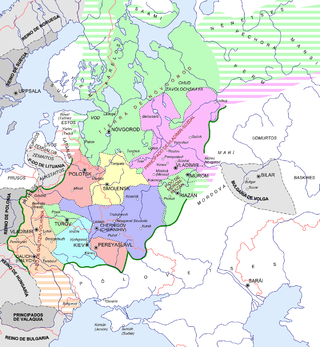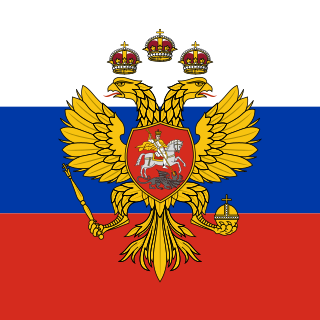
The House of Romanov was the reigning imperial house of Russia from 1613 to 1917. They achieved prominence after Anastasia Romanovna married Ivan the Terrible, the first crowned tsar of all Russia. Nicholas II, the last Emperor of Russia, and his immediate family were executed in 1918, but there are still living descendants of other members of the imperial house.

The Order of Saint Andrew the Apostle the First-Called is the highest order conferred by both the Russian Imperial Family and by the Russian Federation . Established as the first and highest order of chivalry of the Russian Tsardom and the Russian Empire in 1698, it was removed from the honours system under the USSR before being re-established as the top Russian civil and military order in 1998.

The Moscow Conservatory, also officially Tchaikovsky Moscow State Conservatory is a musical educational institution located in Moscow, Russia. It grants undergraduate and graduate degrees in musical performance and musical research. The conservatory offers various degrees including Bachelor of Music Performance, Master of Music and PhD in research.
The Pushkin Prize was a Russian literary award presented to a Russian writer considered to have achieved the highest standard of literary excellence. It was established in 1881 by the Russian Academy of Sciences to honor one of the greatest Russian poets Alexander Pushkin (1799–1837), then discontinued during the Soviet period. It was restored in 1989 by Alfred Toepfer Foundation in Hamburg. In 1995, the State Pushkin Prize was established by Boris Yeltsin's decree, with Vladimir Sokolov being the first laureate. Both lasted till 2005. In 2005 the New Pushkin Prize was established by the Aleksander Zhukov Fund, as well as the Pushkin and Mikhaylovskoye museums. In 2017 the International Creative Contest "World Pushkin" was established by the Russkiy Mir Foundation and the A. Pushkin State Literary Memorial and Natural Museum-Reserve Boldino.

Vasili IV Ivanovich Shuisky was Tsar of all Russia from 1606 to 1610, after the murder of False Dmitri I. His rule coincided with the Time of Troubles. He was the only member of House of Shuisky to become tsar and the last member of the Rurikid dynasty to rule as tsar.

The Great Russian Encyclopedia is a universal Russian encyclopedia, completed in 36 volumes, published between 2004 and 2017 by Great Russian Encyclopedia, JSC. A successor to the Great Soviet Encyclopedia, it was released under the auspices of the Russian Academy of Sciences (RAS) after President Vladimir Putin signed a presidential decree №1156 in 2002. The complete edition was released by 2017.

The inner Principality of Kiev was a medieval principality centered on the city of Kiev.

The State Prize of the Russian Federation, officially translated in Russia as Russian Federation National Award, is a state honorary prize established in 1992 following the breakup of the Soviet Union. In 2004 the rules for selection of laureates and the status of the award were significantly changed, making them closer to such awards as the Nobel Prize or the Soviet Lenin Prize.

The Rurik dynasty, also known as the Rurikid or Riurikid dynasty, as well as simply Rurikids or Riurikids, was a noble lineage allegedly founded by the Varangian prince Rurik, who, according to tradition, established himself at Novgorod in the year 862. The Rurikids were the ruling dynasty of Kievan Rus' and its principalities following its disintegration.
The year 1960 was marked by many events that left an imprint on the history of Soviet and Russian Fine Arts.
Bald–hairy is a common joke in Russian political discourse, referring to the empirical rule of the state leaders' succession defined as a change of a bald or balding leader to a hairy one and vice versa. This consistent pattern can be traced back to as early as 1825, when Nicholas I succeeded his late brother Alexander as the Russian Emperor. Nicholas I's son Alexander II formed the first "bald–hairy" pair of the sequence with his father.
The following lists events that happened during 1991 in the Soviet Union and Russia.
The year 1952 was marked by many events that left an imprint on the history of Soviet and Russian Fine Arts.
The year 1951 was marked by many events that left an imprint on the history of Soviet and Russian Fine Arts.

First National Art Exhibition "Soviet Russia" was one of the largest Soviet art exhibitions of the 1960s. The exhibition took place in Manezh Exhibition Hall.

The Tsar of all Russia, officially the Sovereign, Tsar and Grand Prince of all Russia, was the title of the Russian monarch from 1547 to 1721. During this period, the state was a tsardom.









